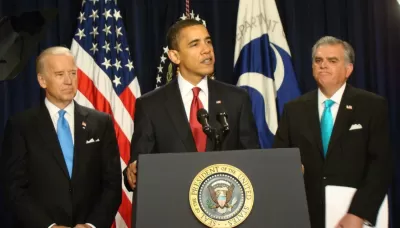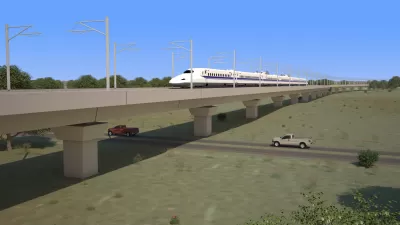Stephen Smith sheds light on the problems of leadership holding back Obama's dream of high-speed rail.

When President Barack Obama first set goals for his federal transportation legacy, he aimed high: access to high-speed rail for 80 percent of Americans within 25 years. Now, at the close of his first term, California is the only state with an HSR system scheduled for completion on-time. As Transportation Secretary Ray LaHood likely prepares to step down next year, Smith argues, it may be prudent for the President to reevaluate the leadership platform of the Transportation Department.
Smith writes, "David Gunn, the president of Amtrak from 2002 to 2005, cited a lack of technical knowledge as the biggest problem at the Transportation Department, which he said has devolved into 'an agency that just distributes money.' " In California, for example, the development and operation of HSR was entrusted to the "California High-Speed Rail Authority, which has little operational experience and a barebones staff." In the process, federal authorities effectively shut out freight rail and Amtrak California, whose collective expertise is critical to the success of the system, according to Gunn.
And it's not merely new projects that suffer from such leadership decisions. "Right now, air, highway and rail interests frequently compete against one another to fill the same need. The government often finances projects to widen and build new highways parallel to new rail routes, depressing ridership and limiting the cost-effectiveness of transit."
Smith concludes, "Other transit analysts, such as Joshua Schank of the Eno Center for Transportation, a research group, agreed that it might be time for a transportation secretary from a technical rather than political background. (The office is sometimes used for bipartisan gestures: LaHood, Obama’s first-term transportation secretary, was a Republican U.S. representative from Illinois, and Norman Mineta, who served under George W. Bush for five years, was a Democratic congressman.) "
FULL STORY: Obama’s New Cabinet Can Make Trains Run on Time

Alabama: Trump Terminates Settlements for Black Communities Harmed By Raw Sewage
Trump deemed the landmark civil rights agreement “illegal DEI and environmental justice policy.”

Study: Maui’s Plan to Convert Vacation Rentals to Long-Term Housing Could Cause Nearly $1 Billion Economic Loss
The plan would reduce visitor accommodation by 25% resulting in 1,900 jobs lost.

Why Should We Subsidize Public Transportation?
Many public transit agencies face financial stress due to rising costs, declining fare revenue, and declining subsidies. Transit advocates must provide a strong business case for increasing public transit funding.

Paris Bike Boom Leads to Steep Drop in Air Pollution
The French city’s air quality has improved dramatically in the past 20 years, coinciding with a growth in cycling.

Why Housing Costs More to Build in California Than in Texas
Hard costs like labor and materials combined with ‘soft’ costs such as permitting make building in the San Francisco Bay Area almost three times as costly as in Texas cities.

San Diego County Sees a Rise in Urban Coyotes
San Diego County experiences a rise in urban coyotes, as sightings become prevalent throughout its urban neighbourhoods and surrounding areas.
Urban Design for Planners 1: Software Tools
This six-course series explores essential urban design concepts using open source software and equips planners with the tools they need to participate fully in the urban design process.
Planning for Universal Design
Learn the tools for implementing Universal Design in planning regulations.
Smith Gee Studio
Alamo Area Metropolitan Planning Organization
City of Santa Clarita
Institute for Housing and Urban Development Studies (IHS)
City of Grandview
Harvard GSD Executive Education
Toledo-Lucas County Plan Commissions
Salt Lake City
NYU Wagner Graduate School of Public Service





























